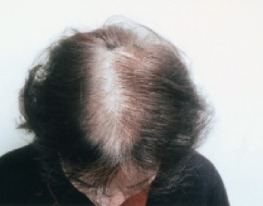About Us

Diffuse hair loss in women
It has been estimated that the scalp normally contains about 100,000 hairs, of which an average 100 hairs are shed daily. This includes hair shed during bathing, grey hair and the smaller finer hair from the hairline and temples which are shed unnoticed. So you may only count 40-50 hair shed each day in your hair brush, your clothes and around your house.
Hair follicles undergo a cyclical and repetitive sequence of growth and rest known as the hair cycle. The growing hair is called the Anagen hair. Over the scalp, the anagen hair continues to grow for 2-6 years; sometimes up to 10 years in women who are capable of growing their hair very long. The anagen hair then goes through a transitional Catagen phase, and finally becomes the resting Telogen hair, which lasts for 3-5 months. At the end of this phase, the telogen hair is eventually shed off, at a rate of 100 telogen hair per day. When women complain of diffuse hair loss, this condition is called Telogen Effluvium. Here there is a 2-3 times increase in the normal hair shedding. It may resolve spontaneously within 6 months ( Acute Telogen Effluvium/ ATE ) or it may persist longer ( Chronic Telogen Effluvium/ CTE ).
CTE is generally a self-limiting condition. This is not a state of actual hair loss or hair thinning. Rather, it is a state of increased hair shedding. To a casual observer, the patient seems to have a full head of hair, although the patient herself is alarmed at the large quantities of hair shed.
This condition is very common after the age of 50 or 60. It is also experienced after child birth, any major illness or surgery, chronic physical or mental stress, medical conditions like anemia, lupus or thyroid disorders, and with certain medications. Sometimes it may be idiopathic, i.e, no cause may be apparent. CTE runs a fluctuating course over several years with periods of waxing and waning. It almost NEVER progresses to actual balding. When there is no apparent cause, or when it happens in women under 40 years of age, or when the excessive hair shedding has persisted for over 3 months, then treatment is warranted to quickly arrest the process.
As mentioned earlier, it is a self – limiting condition which resolves spontaneously over a period of time. The resolution can be hastened by therapy in selected patients. When a specific cause can be found through blood tests, treating the cause can reverse the excessive hair shedding.

Hair follicles undergo a cyclical
and repetitive sequence of growth
and rest known as the hair cycle.
